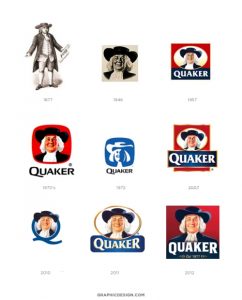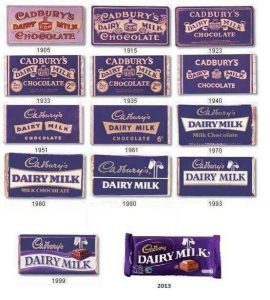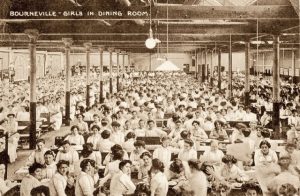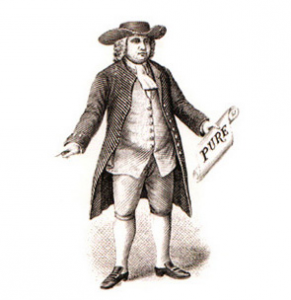Will the real Quakers please stand up.

Quakers are members of a group with Christian roots that began in England in the 1650s. The formal title of the movement is the Society of Friends or the Religious Society of Friends
There are two stories as to how the movement got its name. The first says that the founder, George Fox, once told a magistrate to tremble (quake) at the name of God and the name ‘Quakers’ stuck. The alternative theory is that the name derives from the physical shaking that sometimes went with Quaker religious experiences. There is less controversy about where the name ‘Friends’ comes from. General agreement is that is relates to Jesus’ remark “You are my friends if you do what I command you” (John 15:14).
There are two brands that are linked with Quakers, one is Cadbury and the other is Quaker Oats. Despite the names, it is the former that is really connected to the Quakers.
The Cadburys were a true Quaker family who had moved from Exeter to run a draper’s shop in Birmingham by the start of the 19th Century. At the time Quakers were barred from the universities so could not pursue professions such as medicine and the law. Nor, as pacifists, could they could consider naval or military careers, which is perhaps why they turned their attention to trade.
Quakers are also teetotal and as such keen to promote alternatives to alcohol, so it was perhaps not surprising that in 1824, that John Cadbury opened a tea and coffee shop next door to his father’s drapery in Bull Street.
He was soon to branch out into cocoa, often grinding the beans himself, and by 1831, the shop was devoted entirely to drinking chocolate. By the 1850s, Cadbury had been given a Royal Warrant from Queen Victoria and, in 1860; John’s sons George and Richard imported a Dutch chocolate press and made something akin to what we would recognise as a bar of chocolate.
 It was great success result and the brothers were soon very wealthy. They didn’t however spend all their new gained riches on themselves, instead appalled by deplorable living standards in Birmingham, George and Richard set out on a vision to create a ‘ factory in the country’.
It was great success result and the brothers were soon very wealthy. They didn’t however spend all their new gained riches on themselves, instead appalled by deplorable living standards in Birmingham, George and Richard set out on a vision to create a ‘ factory in the country’.
 They bought a farm on the banks of the River Bourn and named it ‘Bournville’. They built not only a huge factory but also hundreds of bright airy homes with gardens and fruit trees for their workers. The village included open spaces, trees and public baths but of course no pubs. When Richard died in 1899, George placed the entire 1,000-acre community into a trust. Today, many of its 25,000 residents still work for Cadbury and rent their homes from the Bournville Village Trust.
They bought a farm on the banks of the River Bourn and named it ‘Bournville’. They built not only a huge factory but also hundreds of bright airy homes with gardens and fruit trees for their workers. The village included open spaces, trees and public baths but of course no pubs. When Richard died in 1899, George placed the entire 1,000-acre community into a trust. Today, many of its 25,000 residents still work for Cadbury and rent their homes from the Bournville Village Trust.
There are still no pubs in Bournville – and it contains the only alcohol-free branch of Tesco in Britain.
All of which help re-inforce the image of Quakers as upright, honest and decent people, exactly the qualities for which Henry Seymour and William Heston chose the name Quaker Oats
Neither Seymour nor Heston were Quakers, but they selected the Quaker name as a symbol of good quality and honest value.
 Today, General Mills who own the brand say, “The ‘Quaker Man’ does not represent an actual person. His image is that of a man dressed in Quaker garb, chosen because the Quaker faith projected the values of honesty, integrity, purity and strength.”
Today, General Mills who own the brand say, “The ‘Quaker Man’ does not represent an actual person. His image is that of a man dressed in Quaker garb, chosen because the Quaker faith projected the values of honesty, integrity, purity and strength.”
Early Quaker Oats advertising dating back to 1909 seems to contradict this and in fact identifies the “Quaker man” as William Penn, the 17th-century philosopher and early Quaker. The ad refers to him as “standard bearer of the Quakers and of Quaker Oats.”
Resembling classic woodcuts of Penn’s likeness, the Quaker Man figure was depicted full-length, sometimes holding a scroll with the word “Pure” written across it. This image was America’s first registered trademark for a breakfast cereal. The registration took place on September 4th, 1877.
Since then the icon has gone through a number of redesigns and refreshes – to add colour, to take it away again, to slim the figure.
However, one of the most famous provides a link to another famous brand. In 1957 Haddon Sundblom produced a colour head-and-shoulders portrait. Sundblom’s other famous brand characters include Coca-Cola’s original Santa and his Quaker Man is said to actually be a portrait of fellow Coca-Cola artist, Harold W. McCauley.
Generally, the Quakers themselves have not said much about this use (or misuse) of their name but have occasionally expressed their anger. One instance was in 1990, when some Quakers started a letter-writing campaign after a Quaker Oats advertisement depicted Popeye as a “Quaker Man” who used violence against aliens, sharks, and Bluto.
Footnote: British confectionary and Quaker beliefs seem to have gone hand-in-hand as Fry’s, Rowntree’s and Terry’s were all founded by Quaker families too.